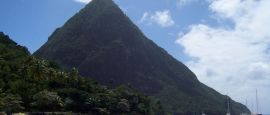Getting around St Lucia
All major centres are served by a reasonably good road network. The main cross-island route runs from Vieux Fort in the south of the island to Castries in the north. Roads are narrow and mountainous roads are steep, often with hairpin bends which are not marked. In rural areas watch out for livestock crossing the road.
You can hire cars in Castries, Soufrière and Vieux Fort, or through hotels. Most cars are suitable for driving in St Lucia, but if you're driving through mountainous terrain or in bad weather conditions, a 4-wheel drive may be your best option. Hotels and local tour operators run coach trips for groups.
Hiring a taxi is easy and cheap. Standard trips usually have fixed rates, but you should agree upon these before you get in as tourists are vulnerable to being overcharged. Doublecheck what currency the taxi driver is quoting (US Dollars or EC Dollars). When hiring a taxi at night, always choose a reputable company. Tipping is unnecessary.
You need to show your national driving licence or International Driving Permit to obtain a temporary local licence. These are available from car hire firms or police stations for a small fee.
Local minibuses run between the towns of Castries, Vieux Fort and Soufrière; these are an affordable option for budget travellers or those wanting an alternative experience. They do tend to be rather overcrowded however, and timetables can be unreliable.
Do you have any Feedback about this page?
© 2025 Columbus Travel Media Ltd. All rights reserved. No part of this site may be reproduced without our written permission, click here for information on Columbus Content Solutions.




 You know where
You know where